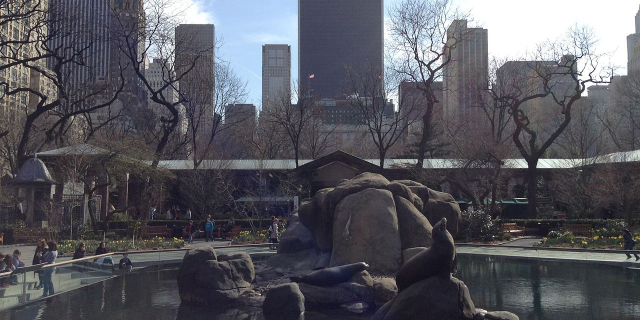Cleopatra's Needle in New York City is one of a pair of obelisks, together named Cleopatra's Needles, that were moved from the ruins of the Caesareum of Alexandria, Egypt, in the 19th century. The stele, dating from the 15th century B.C., was installed in Central Park, west of the Metropolitan Museum of Art's main building in Manhattan, on February 22, 1881. It was secured in May 1877 by judge Elbert E. Farman, the United States Consul General at Cairo, as a gift from the Khedive for the United States remaining a friendly neutral as two European powers, France and Britain, maneuvered for political control of the Egyptian government. The transportation costs were largely paid by a railroad magnate, William Henry Vanderbilt, the eldest son of Cornelius Vanderbilt.
Made of red granite, the obelisk stands about 21 metres (69 ft) high, weighs about 200 tons,[1] and is inscribed with Egyptian hieroglyphs. Originally erected in the Egyptian city of Heliopolis on the orders of Thutmose III, in 1475 BC,[1] the obelisk's granite was mined from the quarries of Aswan near the first cataract of the Nile. The inscriptions were added about 200 years later by Ramesses II to commemorate his military victories.
The obelisks were moved to Alexandria and set up in the Caesareum—a temple built by Cleopatra in honor of Mark Antony or Julius Caesar—by the Romans in 13/12 BC, during the reign of Augustus.[2] However, the obelisks were toppled some time later. This had the fortuitous effect of burying their faces and so preserving most of the hieroglyphs from the effects of weathering.
American acquisitionThe original idea to secure an Egyptian obelisk for New York City came from the March 1877 New York City newspaper accounts of the transporting of the London obelisk. The newspapers mistakenly attributed to a John Dixon the 1869 proposal of the Khedive of Egypt, Isma'il Pasha, to give the United States an obelisk as a gift for increased trade. Dixon, the contractor who, in 1877, arranged the transport of the London obelisk, denied the newspaper accounts.
In March 1877, Henry G. Stebbins, Commissioner of the Department of Public Parks of the City of New York, undertook to secure the funding to transport the obelisk to New York.[3] However, when railroad magnate William H. Vanderbilt was asked to head the subscription, he offered to finance the project with a donation of more than US$100,000 (equivalent to $2,748,125 in 2022).[4]
Stebbins then sent two acceptance letters to the Khedive through the Department of State which forwarded them to Judge Farman in Cairo. Realizing that he might be able to secure one of the two remaining upright obelisks—either the mate to the Paris obelisk in Luxor or the London mate in Alexandria—Judge Farman formally asked the Khedive in March 1877, and by May 1877 he had secured the gift in writing.[3]: ch.XIV
Importing Placing the obelisk in the hold of the steamship Dessoug
Placing the obelisk in the hold of the steamship DessougThe formidable task of moving the obelisk from Alexandria to New York was given to Henry Honychurch Gorringe, a lieutenant commander on leave from the U.S. Navy. The 200-ton granite obelisk was first shifted from vertical to horizontal, nearly crashing to ground in the process. In August 1879[5] the movement process was suspended for two months because of local protests and legal challenges. Once those were resolved, the obelisk was transported seven miles to Alexandria and then put into the hold of the steamship SS Dessoug, which set sail June 12, 1880.[3]: Ch.XVI The Dessoug was heavily modified with a large hole cut into the starboard side of its bow. The obelisk was loaded through the ship's hull by rolling it upon cannonballs.[6]
Even with a broken propeller, the SS Dessoug was able to make the journey to the United States.[6] The obelisk and its 50-ton pedestal arrived at the Quarantine Station in New York in early July 1880. It took 32 horses hitched in pairs to bring it from the banks of the East River to Central Park. Railroad ramps and tracks had to be temporarily removed and the ground flattened so that the obelisk could be rolled out of the ship, whose side had been cut open once again for the purpose. The obelisk was carried up the East River and transported to a temporary location off Fifth Avenue.[1] The final leg of the journey was made by pushing the obelisk with a steam engine across a specially built trestle bridge from Fifth Avenue to its new home on Greywacke Knoll, just across the drive from the Metropolitan Museum of Art.[7] It took 112 days to move the obelisk from Quarantine Station to its resting place.[8]
Jesse B. Anthony, Grand Master of Masons in the State of New York, presided as the cornerstone for the obelisk was laid in place with full Masonic ceremony on October 2, 1880.[9] Over 9,000 Masons paraded up Fifth Avenue from 14th Street to 82nd Street, and it was estimated that over 50,000 spectators lined the parade route. The benediction was presented by Rev. J. Bradford Cleaver. The obelisk was righted by a special structure built by Henry Honychurch Gorringe. The official ceremony for erecting the obelisk was held January 22, 1881. The event was commemorated a month later with another ceremony inside the Metropolitan Museum of Art.





























Add new comment